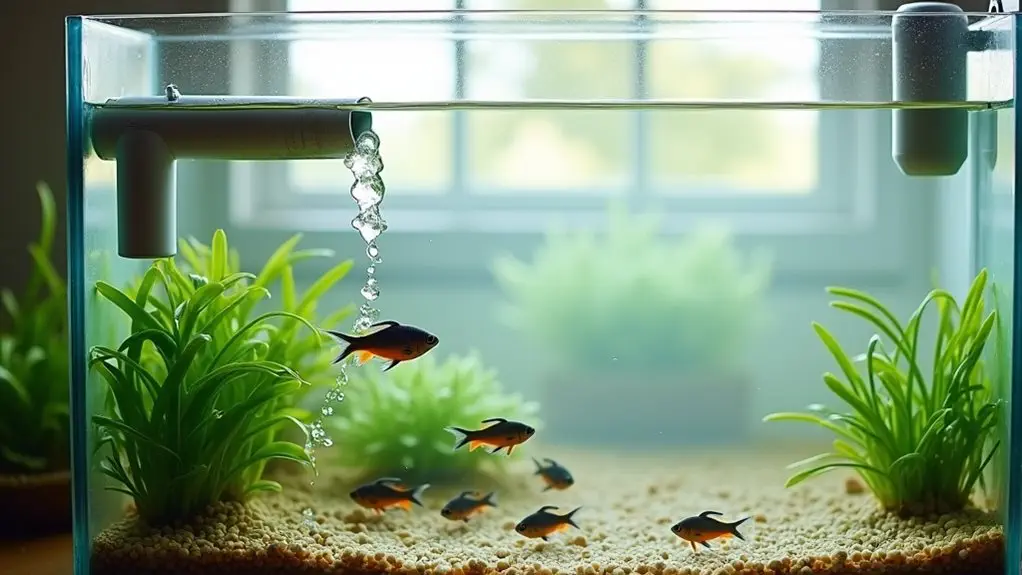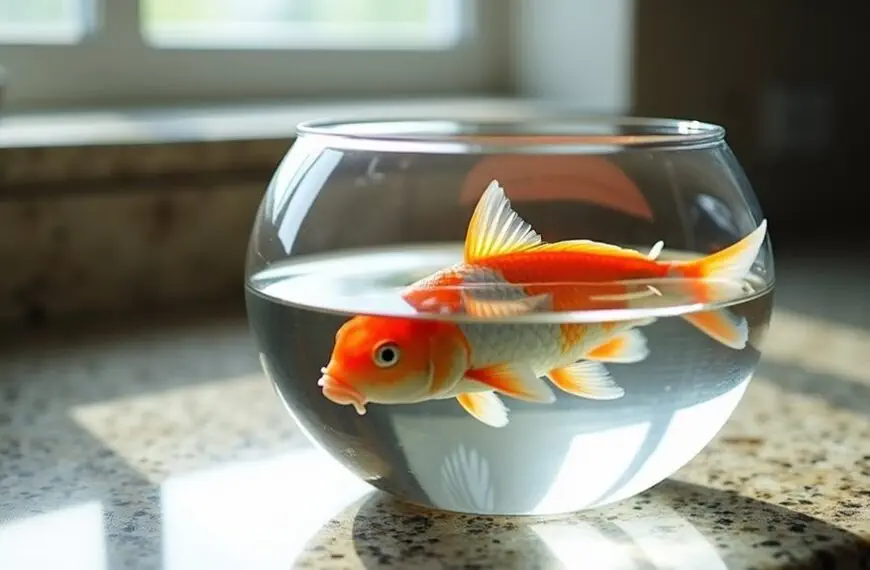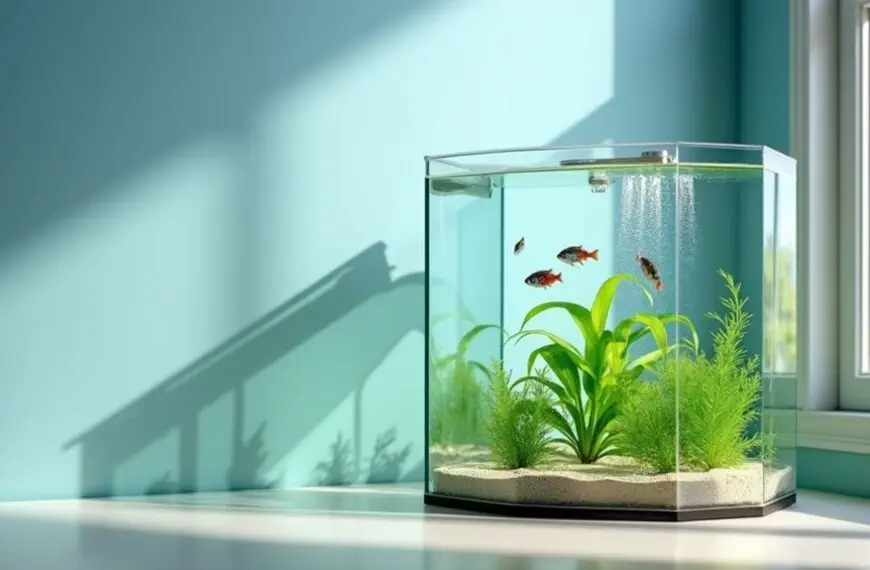No, you shouldn't remove all the water when cleaning your fish tank, as this can seriously stress your fish and destroy beneficial bacteria that keep your aquarium healthy. Instead, aim to change 15-30% of the water during routine maintenance, which helps dilute harmful chemicals while preserving the tank's delicate ecosystem. Make sure to vacuum the gravel, scrape algae from walls, and use a water conditioner with each partial change. Regular, smaller water changes are much better for your finned friends than complete overhauls, and maintaining this simple routine will lead to happier, healthier fish and a more stable aquarium environment.
Contents
- 1 Why Full Water Changes Harm
- 2 The Right Amount to Remove
- 3 Essential Steps During Water Changes
- 4 Preserving Beneficial Tank Bacteria
- 5 Best Cleaning Practices and Schedule
- 6 Frequently Asked Questions
- 6.1 Can I Use Bottled Spring Water Instead of Tap Water?
- 6.2 How Long Should I Wait Before Adding Fish After Cleaning?
- 6.3 What Happens if My Filter Accidentally Dries Out Completely?
- 6.4 Should I Clean My Tank More Frequently During Fish Breeding Seasons?
- 6.5 Can Power Outages During Water Changes Harm My Aquarium's Ecosystem?
- 7 Final Thoughts
Why Full Water Changes Harm
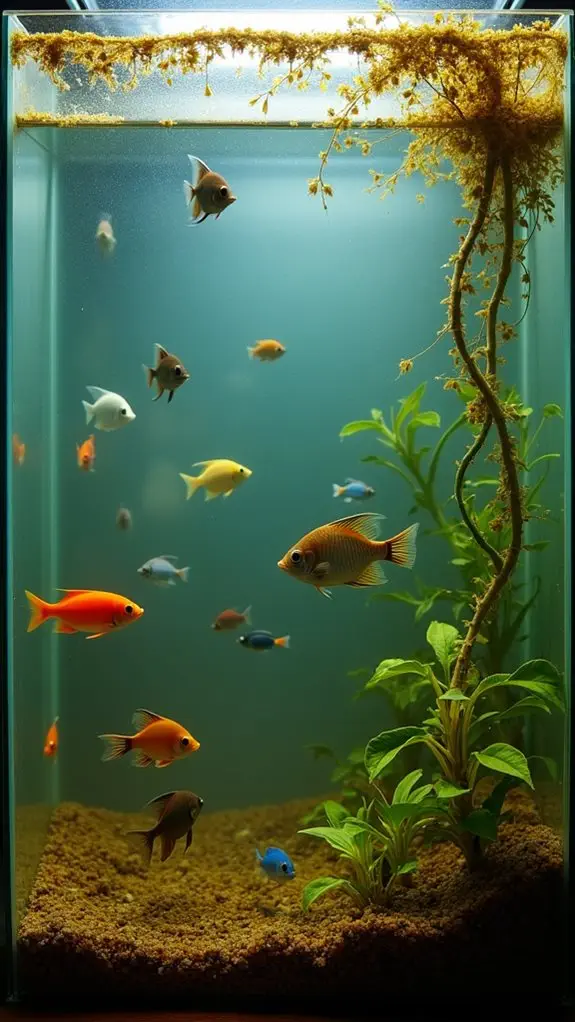
A common mistake among new aquarium owners is performing complete water changes, which can severely harm fish populations. While you might think removing all the water will give your fish the cleanest environment possible, it actually introduces multiple stress factors that can threaten their health and survival.
When you perform a complete water change, you're disrupting your tank's delicate pH stability and shocking your fish's system. It's like suddenly moving them from their comfortable home to a completely different environment! Over time, fish develop a natural resistance to gradual changes in their environment, and sudden shifts can lead to serious health issues. The new water's temperature and chemistry can vary greatly from what your fish are used to, weakening their immune systems and making them more susceptible to disease. Regular cleaning schedules with bi-weekly maintenance help prevent the need for drastic water changes.
You'll also be removing beneficial bacteria that help break down harmful ammonia – these microscopic helpers are your fish's best friends! Maintaining a stable environment through partial water changes is vital for preventing toxic buildup in your tank.
Instead of full water changes, opt for regular partial changes of about 10-25% of the water. This gentler approach maintains water quality while preserving the tank's biological balance.
Your fish will thank you by staying healthier, more active, and less stressed – and you'll have fewer problems to deal with in the long run.
The Right Amount to Remove
Finding the right amount of water to remove during tank maintenance depends on several key factors unique to your aquarium. Your tank's bio-load, which includes how many fish you have and how much you're feeding them, plays a major role in determining the ideal water volume to change. Tap water treatment is essential before adding new water to your tank.
Regular water changes help maintain stable conditions in your aquarium ecosystem. For most established tanks, you'll want to stick to changing 10-25% of the water every couple of weeks. If you've got a heavily stocked tank that's bustling with fishy friends, you'll need more frequent changes – about 50% every two weeks should do the trick.
But if your tank's more of a peaceful retreat with just a few residents, you can get away with less frequent maintenance. Remember, keeping an eye on your tank's conditions helps support beneficial bacteria, as they play a crucial role in maintaining a healthy aquatic environment.
Keep an eye on those nitrate levels – they'll tell you if you need to adjust your water change schedule. You'll want to keep them below 80 ppm to guarantee your fish stay healthy and stress-free.
Essential Steps During Water Changes
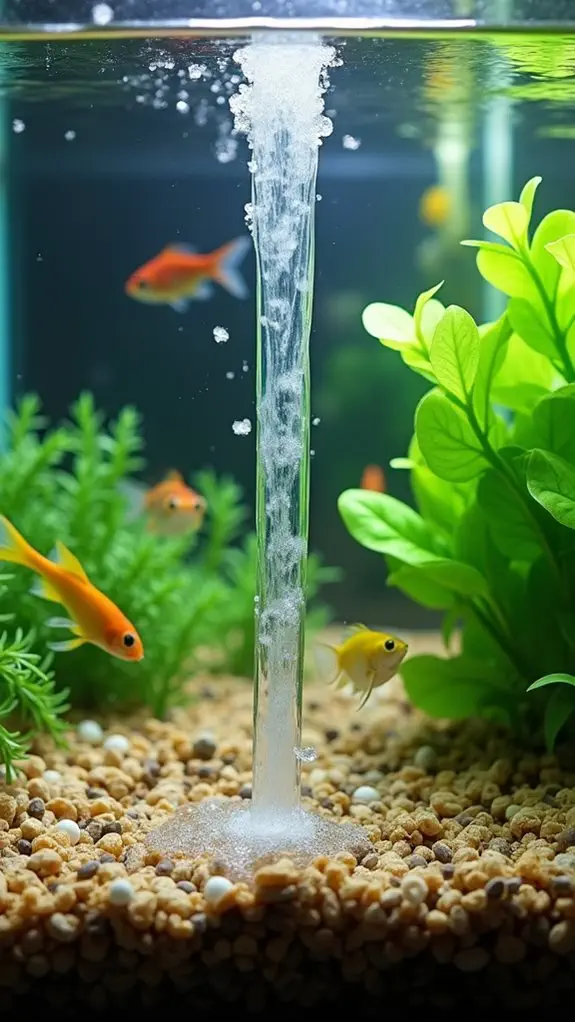
Now that you know how much water to remove, let's focus on the proper steps to complete an effective water change. To maintain peak water quality and guarantee your fish's health, you'll need to follow a careful sequence of actions during cleaning.
Using a dedicated bucket for maintenance tasks helps prevent cross-contamination with household cleaners and keeps your aquarium safe for fish. Clean supplies are essential for proper tank maintenance. Regularly testing your water parameters can help ensure that your fish thrive in balanced water conditions.
Start by unplugging your filter, lights, and heater – think of it as giving your tank's electronics a little coffee break!
While they're resting, remove your decorations and plants, placing them in separate buckets for a thorough cleaning. You'll want to use your gravel vacuum to clean the substrate, moving it up and down gently to remove waste and leftover food. Regular maintenance on a specific day each week helps establish a consistent cleaning routine.
Don't forget, you're only removing 15-30% of the water during this process.
When it's time to add fresh water, you'll need to treat it with a dechlorinator first. Make sure the new water matches your tank's temperature – your fish don't appreciate sudden hot or cold splashes!
Add the water slowly, and don't forget to prime your filter before turning everything back on.
Just like that, you've completed a proper water change that'll keep your aquatic friends happy and healthy.
Preserving Beneficial Tank Bacteria
Beneficial bacteria serve as your tank's invisible cleanup crew, breaking down harmful waste and maintaining water quality. When performing tank maintenance, you'll want to protect these microscopic helpers that keep your aquatic friends healthy and happy. During this time, it's crucial to remember that beneficial bacteria primarily thrive in the filter media, where nitrifying bacteria efficiently convert toxins into less harmful substances.
Think of them as your tank's essential workforce – you wouldn't want to accidentally send them all on vacation at once! Experts recommend performing partial water changes weekly or monthly depending on your tank's size and population.
To guarantee proper bacteria preservation, never rinse your filter media in tap water – the chlorine will kill your beneficial bacteria faster than you can say "fish food." Instead, use old tank water to clean your filter materials, and don't replace more than a quarter of the media at once.
During substrate changes, keep your filter and rocks in a bucket of old tank water to maintain your biological cycle.
When you're cleaning your tank, avoid using harsh chemicals that could harm your bacterial colonies. If you need to disinfect something, hydrogen peroxide is a gentler option, but you'll still need to rinse thoroughly. Using bleach is particularly risky as it can leave behind harmful residues in porous materials.
Best Cleaning Practices and Schedule
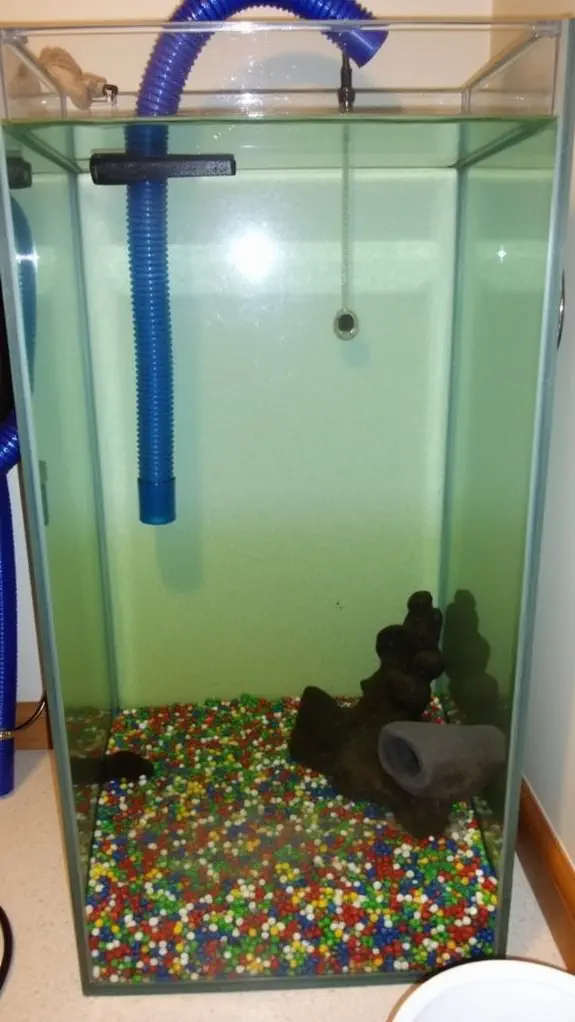
With your bacterial helpers safely protected, let's map out a practical cleaning routine that'll keep your aquarium sparkling clean.
You'll want to establish a consistent cleaning frequency that maintains peak water quality without overdoing it. Daily checks are simple – just make sure your equipment's running smoothly and remove any uneaten food floating around. Quick monitoring of your fish's eating behavior is essential for assessing their health.
Your weekly routine should include testing the water parameters and performing a 25% water change – think of it as a mini spa day for your fish! During these changes, you'll vacuum the gravel and scrape off any stubborn algae from the tank walls. Regular water changes help dilute harmful chemicals, ensuring a healthier environment for your fish and keeping nitrate levels below 40 ppm. Consider installing a UV sterilizer system to reduce algae and bacteria growth between cleanings.
Don't forget to add water conditioners and beneficial bacteria after each change.
Every other week, give your synthetic decorations a good scrub with hot water (no soap needed!), and check your filter media.
Monthly maintenance is where you'll tackle the bigger jobs: inspecting equipment, replacing worn parts, and giving those decorations a deeper clean.
If you're running a saltwater tank, you'll need to stick to weekly maintenance – those marine ecosystems are a bit more demanding, but your fish will thank you for the extra attention!
Frequently Asked Questions
Can I Use Bottled Spring Water Instead of Tap Water?
You can use bottled spring water instead of tap, but it's not always necessary. While spring water offers benefits, treated tap water works well for most fish tanks and is more cost-effective.
How Long Should I Wait Before Adding Fish After Cleaning?
You'll need to wait 2-3 days after cleaning before adding fish. During this time, maintain stable water temperature and complete the acclimation process properly when introducing new fish to your tank.
What Happens if My Filter Accidentally Dries Out Completely?
If your filter dries out completely, you'll lose beneficial bacteria and need to restart the tank cycling process. During filter recovery, you'll need careful tank maintenance to prevent ammonia spikes that harm fish.
Should I Clean My Tank More Frequently During Fish Breeding Seasons?
You'll need to clean your tank more frequently during breeding seasons to maintain ideal tank conditions. Increased waste from breeding behavior and fry development requires closer monitoring and more regular maintenance.
Can Power Outages During Water Changes Harm My Aquarium's Ecosystem?
Yes, power outages during water changes can seriously disrupt your aquarium's stability. You'll face risks like temperature fluctuations and oxygen depletion. It's best to postpone water changes if you're expecting power outage effects.
Final Thoughts
You'll want to stick to changing 10-25% of your tank's water during routine maintenance, never removing it all at once. This partial approach keeps your fishy friends happy while preserving the beneficial bacteria they need to thrive. By following proper cleaning steps and maintaining a regular schedule, you're creating a healthy environment that'll keep your aquatic pets swimming contentedly for years to come.

